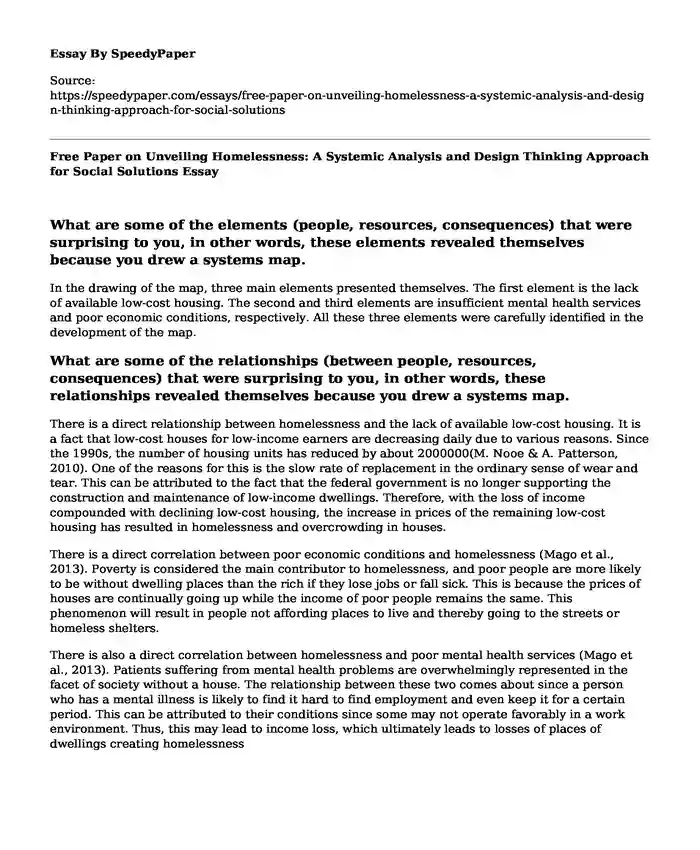What are some of the elements (people, resources, consequences) that were surprising to you, in other words, these elements revealed themselves because you drew a systems map.
In the drawing of the map, three main elements presented themselves. The first element is the lack of available low-cost housing. The second and third elements are insufficient mental health services and poor economic conditions, respectively. All these three elements were carefully identified in the development of the map.
What are some of the relationships (between people, resources, consequences) that were surprising to you, in other words, these relationships revealed themselves because you drew a systems map.
There is a direct relationship between homelessness and the lack of available low-cost housing. It is a fact that low-cost houses for low-income earners are decreasing daily due to various reasons. Since the 1990s, the number of housing units has reduced by about 2000000(M. Nooe & A. Patterson, 2010). One of the reasons for this is the slow rate of replacement in the ordinary sense of wear and tear. This can be attributed to the fact that the federal government is no longer supporting the construction and maintenance of low-income dwellings. Therefore, with the loss of income compounded with declining low-cost housing, the increase in prices of the remaining low-cost housing has resulted in homelessness and overcrowding in houses.
There is a direct correlation between poor economic conditions and homelessness (Mago et al., 2013). Poverty is considered the main contributor to homelessness, and poor people are more likely to be without dwelling places than the rich if they lose jobs or fall sick. This is because the prices of houses are continually going up while the income of poor people remains the same. This phenomenon will result in people not affording places to live and thereby going to the streets or homeless shelters.
There is also a direct correlation between homelessness and poor mental health services (Mago et al., 2013). Patients suffering from mental health problems are overwhelmingly represented in the facet of society without a house. The relationship between these two comes about since a person who has a mental illness is likely to find it hard to find employment and even keep it for a certain period. This can be attributed to their conditions since some may not operate favorably in a work environment. Thus, this may lead to income loss, which ultimately leads to losses of places of dwellings creating homelessness
List at least three takeaways that your team will apply in designing your social enterprise.
The first important takeaway is the incorporation of design thinking in the social enterprise. Design thinking is constructive since it utilizes maps to show the state of things and how things relate to each other. For instance, the system map has helped this project to identify the other elements concerning homelessness. It is possible through the use of mapping.
The second takeaway is that it is essential to have a clear and well-thought-out objective. The objective can be cultural, environmental, social, or even financial. This objective must be communicated to all persons so that it can be attained.
The third takeaway is incorporating a belief that the solution provided will help tackle the social problem. In order for something to work, there needs to be confidence in that effect. Regarding a social enterprise, belief is vital that it will have a social impact.
References
M. Nooe, R., & A. Patterson, D. (2010). The Ecology of Homelessness. Taylor & Francis. Retrieved 21 September 2020, from https://www.tandfonline.com/doi/full/10.1080/10911350903269757.
Mago, V., Morden, H., Fritz, C., Wu, T., Namazi, S., & Geranmayeh, P. et al. (2013). Analyzing the impact of social factors on homelessness: a Fuzzy Cognitive Map approach. Semanticscholar.org. Retrieved 21 September 2020, from https://www.semanticscholar.org/paper/Analyzing-the-impact-of-social-factors-on-a-Fuzzy-Mago-Morden/4036a76915bd59b709c08e95f72db1f1b47adc32.
Cite this page
Free Paper on Unveiling Homelessness: A Systemic Analysis and Design Thinking Approach for Social Solutions. (2023, Dec 20). Retrieved from https://speedypaper.com/essays/free-paper-on-unveiling-homelessness-a-systemic-analysis-and-design-thinking-approach-for-social-solutions
Request Removal
If you are the original author of this essay and no longer wish to have it published on the SpeedyPaper website, please click below to request its removal:
- HRM Essay Sample: Affirmative Action Plan
- Free Essay on Gender Roles in Society in America
- The US-Mexico Border and the Trump Wall, Essay Example
- Paper Example. Fannie Lou Hamer
- Paper Example: Conservation Plan for Chimpanzee
- Essay Sample on Homelessness and Service
- Essay Example: The Double Standard of Aging
Popular categories





